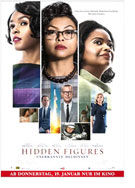

Opening 2 Feb 2017
Directed by:
Theodore Melfi
Writing credits:
Alison Schroeder, Theodore Melfi
Principal actors:
Taraji Melfi, Octavia Spencer, Janelle Monáe, Kevin Costner, Kirsten Dunst
World-changing historical events and its key players are recorded for prosperity. Occasionally after the fact, the unsung heroes receive tribute. Director Theodore Melfi, basing his co-scripted screenplay with Allison Schroeder on Margot Lee Shetterly’s book, commingles civil/women’s rights, science/space travel, technology, and compelling drama. Incorporating pertinent archival footage—television, film—fuels audiences’ attention, as the race to the moon did in the 1960s.
NASA’s (National Aeronautical and Space Administration) program at Langley, Virginia gets a setback in 1961 when Russia’s space competition accelerates. Amidst a tense atmosphere, the Space Agency discovers a team of impressively intelligent, competent fresh talent. Holding them back: sex/color. Three plucky gals with inherent, mainly untapped talents: mathematical prowess, technological skill, management proclivity, and significantly, curiosity and fearless disregard for dreaming big. “Look beyond the numbers, they don’t exist,” Al Harrison (Costner is formidable) barks; John Glen (a sound Glen Powell), itching to reach the moon, knows the importance of mathematical equations; at a crucial juncture he puts his trust in “the smart one.”
Embracing their characters are Taraji P. Henson (Katherine Johnson), Octavia Spencer (Dorothy Vaughan), and Janelle Monáe (Mary Jackson). Solidly, eloquently projecting the challenges black women daily faced, then repelled with dignity and resilience. Their lifestyles and friendships, including infringements on the community’s civil rights, are established. Kirsten Dunst (Vivian Michael) compellingly portrays the insensitive, racially biased administrator. Missy Parker’s sets, Jeremy Woolsey’s art direction, Wynn Thomas’ production design recreate the times. Enhanced by Mandy Walker’s cinematography that editor Peter Teschner constructs into this fluidly memorable film.
Director Melfi, the resounding cast, and exemplary crew unite in portraying a fascinatingly complex yet pivotal point in history, finishing with a montage of the actual women and current biographical information. “You can’t rewrite history,” any more than you can afford to miss this film. (Marinell Haegelin)
It’s the middle of the 1950s as two great nations compete in this 20th century cold war race to see who will reach the stars first. It wasn’t until the Soviet dog Laika first travelled into space that the National Aeronautics and Space Administration felt the heat from Washington. Who will be the first to put a man into space? In this day and time period, there were no machines, such as computers, that could do the work. So, groups of teams took over the mathematical work; one such group included three very talented African American women who were tucked back in some basement calculating and dreaming about what they could do for the future. Strangely enough we know the names of the first two men, Alan Shepard and John Glen, who put into space but most of us had no idea of what happened behind the scenes of this important event and who was responsible until this movie came out.
So who is Katherine G. Johnson? Here are some facts that the movie doesn’t tell you. She was born in 1918 and was already a freshman in high school at age 10. She started working for NASA in 1953 as a human calculator and was the brilliant mathematician/ physicist who worked on the trajectories for both Shepard and Glen. In 2015 she was the recipient of the Nation’s Highest Civilian Honor Metal. Who was Dorothy Vaughan? She was born in 1910 and graduated from high school when she was 15 and received a scholarship for university. She graduated as a mathematician at age 19. Her career started at Langley Research Center in 1943 where she worked for 28 years. She taught herself FORTRAN and specialized in calculating flight paths. She lived to be 98 years old and one of her children later worked for NASA. And who is Mary Jackson? She was born in 1921 and earned a B.A. in mathematics and physics in 1943and started working under Dorothy Vaughan in 1958. She went on to become NASA’s first African American female engineer. She died at age 83.
This film brings up many issues, starting with civil/women’s rights, science and technology and shows what we can achieve if we overlook our differences: a man orbiting our planet and later going out to space. The characters of these women represent a guiding light to all of us in these dark times. They showed us what can be achieved when thinking beyond the box, i.e., to be patient and strong even when things appear not to be fair, to support each other, and to go further down the road. I felt a beacon of light telling me that we can survive what lies ahead of us but we need to stand together. Its seems strange that in 1942 Franklin D. Roosevelt desegregated the military section of the government so that they could get the job done and still in the 1960s we had segregated bathrooms, buses, schools, libraries, etc. This brings us to the current question, “Are we moving forward now or are we heading backwards in time where we need to take a stand?” This film gets right down to business starting with the basic needs such as black toilets/white toilets. There never seems to be enough toilets for women but Hidden Figures Katherine G. Johnson (Taraji P. Henson), Dorothy Vaughan (Octavia Spencer), and Mary Jackson (Janelle Monae) are struggling to put that man into space and can barely make it to the bathroom. Something was clearly wrong back then; let’s not do it again to ourselves. (Shelly Schoeneshoefer)